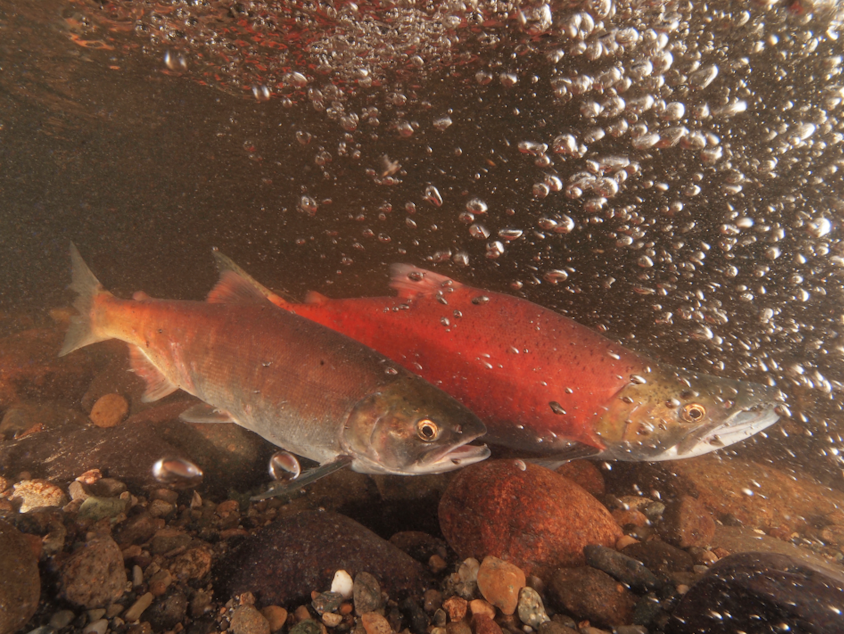Extinction could be a hot summer away for the little red fish of Lake Sammamish

A little red fish that calls Lake Sammamish home is swimming desperately close to extinction. Officials are embarking on emergency measures to keep the fish known as kokanee from disappearing from the lake, and King County, forever.
The lake's populations of kokanee, a variety of sockeye salmon that never leaves fresh water, often fluctuate. But they have plummeted drastically in the past four years.
Just 19 of them headed upstream from Lake Sammamish to spawn last fall. Five years ago, that number exceeded 18,000.
"We must take concerted action right now to save the iconic kokanee from extinction," King County Executive Dow Constantine said Tuesday on the banks of Ebright Creek, a shady, gurgling stream that flows into Lake Sammamish and hosts spawning kokanee each fall.
City, county, tribal and nonprofit leaders announced a package of projects to restore kokanee habitat and revive the little red fishes' populations.
Sponsored
"It's about time," Snoqualmie Tribe chief Andy de los Angeles said. "Zackuse Creek and other creeks, they were dead for so many years."
A century ago, Snoqualmie Indians trapped kokanee near the mouth of Ebright Creek and hung them on drying racks in nearby fields. For centuries, tribes relied on the fatty little fish as a staple food: The flesh dried and stored well, powering people through the lean winter months.
"If we didn’t have these kokanee, us as a tribe might not’ve been here," Snoqualmie Tribal Council member Michael Ross said. "If something isn’t done now, not our children, not our grandchildren, we in our lifetime won’t see any more kokanee."
Anglers can pursue kokanee pumped out by centralized hatcheries and dumped into lakes around the western United States. To the north, in British Columbia, wild kokanee can be found in hundreds of lakes.
But in Washington state, the wild kokanee, with its distinct DNA, is thought to survive in only four lakes: Chilliwack, Ozette, Whatcom and seven-mile-long Sammamish, near the eastern edge of Seattle's suburbs.
Sponsored
The late-autumn run of kokanee in a handful of creeks on the east side of Lake Sammamish is all that's left of a much-larger population of kokanee that thrived in that lake and Lake Washington, its much-larger, urban neighbor to the west.
Scientists watched helplessly as a summer-spawning run disappeared from Lake Sammamish.
"We’re really trying to make sure the same thing doesn’t happen with this population," King County biologist James Bower said. "That’s why we’re being so proactive."
Scientists can't say for sure why Sammamish's kokanee are dying off. But three hot summers in a row have been hard on the cold-water creatures.
"What was unique was that we had three years in a row, '14, '15, '16, that were particularly intense," Bower said.
Sponsored
Habitat lost to roads and driveways and their polluted runoff might also play a role, as could parasites in the lake.
Public and private groups in the Sammamish area are getting rid of barriers like road culverts that have blocked fish from reaching miles of spawning grounds. They're also breeding young kokanee to reestablish them in creeks that have long been out of reach.
Sammamish officials expect to un-block Zackuse Creek this summer by replacing fish-stopping culverts beneath East Lake Sammamish Parkway.
"The city of Sammamish made an effort to expedite that, knowing there is what we hope to be a significant run [of kokanee] this fall," Sammamish Mayor Christie Malchow said.
The city and its partners are also considering cryogenics — a frozen sperm bank for fish — as a last-ditch effort to help the very small numbers of naturally mating kokanee avoid a genetic bottleneck.
Sponsored
"We really hope we don’t have to use it," Bower said.
The aim would be to foster genepool-stirring love connections between fishes that might not meet in the real world if they go out to spawn in different weeks or years.
Kokanee, like most salmon, spawn once then die.
Fans of kokanee are also crossing their fingers that temperatures this summer won’t put the kokanee in more hot water.
Scientists hope that measures like restoring creeks around Lake Sammamish will give the kokanee a fighting chance at surviving the ever-warmer climate of the 21st century.

